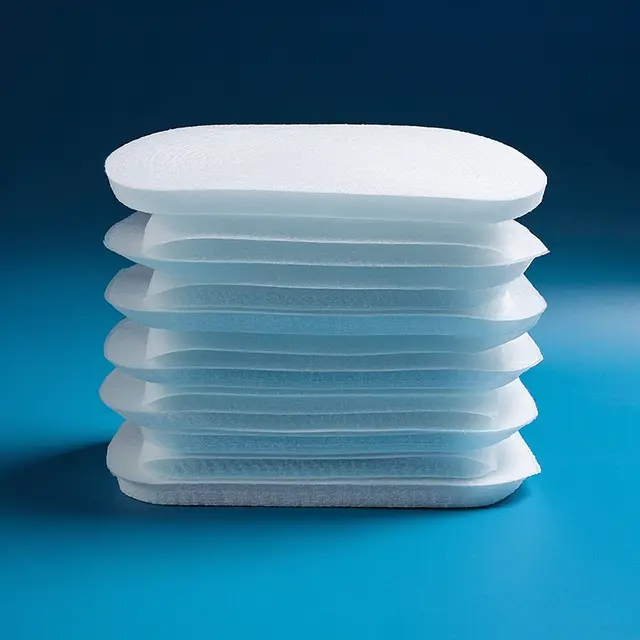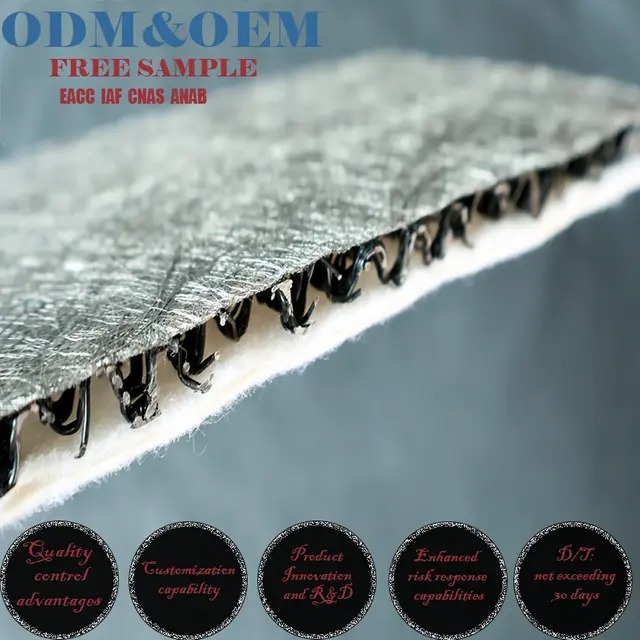- All
- Product Name
- Product Keyword
- Product Model
- Product Summary
- Product Description
- Multi Field Search

Views: 168 Author: Site Editor Publish Time: 2025-08-14 Origin: Site
Coarse filament non-woven fabric is an industrial-grade textile material made from thick, high-denier synthetic fibers, typically polyester or polypropylene, that are bonded together without weaving or knitting. This unique material offers strength, stiffness, dimensional stability, and high permeability, making it a preferred choice in various demanding applications such as building materials, filter media, and decorative interiors.
In this article, we’ll explore what makes coarse filament non-woven fabric stand out, how it is manufactured, where it’s used, and how to choose the right type for your industry-specific needs.
The term coarse filament refers to synthetic fibers with relatively high denier—typically above 6D. In simple terms, the denier rating represents the thickness of the filament; the higher the number, the thicker and coarser the fiber. When these coarse fibers are formed into non-woven fabric using bonding techniques such as thermal bonding, needle punching, or spunbond processing, they create a durable, breathable, and highly structured textile.
Unlike traditional woven fabrics, coarse filament non-woven fabrics are created directly from polymer chips or granules. These polymers are melted, extruded through spinnerets, and laid randomly or in layers before being bonded. The result is a fabric that does not fray, has a uniform pore structure, and can be tailored for a wide range of technical functions.
This type of non-woven fabric exhibits excellent resistance to wear and tear, UV radiation, moisture, and chemical degradation, making it ideal for long-term use in rugged environments.

One of the largest application areas for coarse filament non-woven fabric is in the construction and civil engineering sectors. The material is commonly used as:
Geotextiles for soil reinforcement, erosion control, and drainage.
Roofing base layers due to its thermal stability and weather resistance.
Concrete curing blankets that retain moisture and enhance hydration.
Underlayment for flooring to provide structure and sound insulation.
Its coarse fiber structure allows for exceptional tensile strength and dimensional stability, critical for large-scale construction projects. The porous nature of the material also aids in moisture wicking and vapor permeability, which is crucial in preventing mold buildup in walls and roofing systems.
In filtration systems, coarse filament non-woven fabric serves as both a pre-filter and structural reinforcement layer. Its consistent pore size distribution allows it to trap larger particles without clogging rapidly, which extends the life of the main filtration unit.
Some key uses include:
Air filters in industrial HVAC systems.
Liquid filtration for chemicals and wastewater.
Dust collection units in manufacturing plants.
Unlike fine fiber non-woven alternatives that may collapse or degrade under pressure or chemical exposure, coarse filament variants maintain their integrity, especially in high-load applications.
While functionality drives its use in construction and filtration, coarse filament non-woven fabric is also employed in decorative settings due to its unique texture and form-retaining properties.
Common decorative uses:
Wall cladding substrates for fabric-covered panels.
Lamination base material for furniture and interior partitions.
Event and stage decorations, where stiffness and strength are required for large hanging installations.
Its ease of dyeing, cutting, and molding makes it a go-to material for designers seeking industrial chic or structured aesthetics.
The manufacturing of coarse filament non-woven fabric generally follows a spunbond process, optimized to work with high-denier filaments. Here's an overview of the steps:
Polymer Melting – Thermoplastic granules (e.g., polyester) are melted in an extruder.
Filament Extrusion – The molten polymer is passed through spinnerets to form continuous coarse filaments.
Web Formation – These filaments are laid on a conveyor belt, either randomly (for isotropic strength) or in a controlled pattern.
Bonding – The fiber web is bonded using thermal calendering, needle punching, or hydroentangling.
Finishing – Optional steps include slitting, rolling, dyeing, printing, or adding flame-retardant or water-repellent coatings.
This continuous production method ensures uniformity and scale, enabling large rolls of fabric that maintain consistent quality throughout.
Below is a summary of the common specifications and performance metrics associated with coarse filament non-woven fabric:
| Property | Typical Value Range |
|---|---|
| Fiber Denier | 6D to 15D |
| Weight (gsm) | 60–200 gsm |
| Thickness | 0.5 mm – 3 mm |
| Tensile Strength | ≥ 150 N/5cm (varies by bonding method) |
| Air Permeability | 200–1000 L/m²/s |
| UV Resistance | High (with optional stabilizer treatments) |
| Water Resistance | Optional hydrophobic coating available |
| Thermal Resistance | -40°C to +120°C (depending on polymer used) |
These characteristics can be adjusted by varying the denier, bonding technique, or adding special chemical treatments. This tunability is what makes the fabric so widely adopted in industrial settings.

Selecting the right type of coarse filament non-woven fabric depends heavily on your application. Here are some considerations:
Load and Strength Requirements – For structural applications like geotextiles or flooring, choose higher denier and needle-punched variants.
Environmental Exposure – For outdoor use, UV-stabilized polyester-based fabrics are preferable.
Filtration Efficiency – Match pore size to particle size. A coarser pore is suitable for pre-filters or large particulate separation.
Flame and Chemical Resistance – For industrial or high-risk environments, check for compliance with fire safety standards and chemical resistance ratings.
You should also consider the roll width, fabric color, and surface finish based on the intended integration method, such as lamination, bonding, or standalone use.
It depends on the polymer used. While traditional versions are made from petroleum-based materials, many manufacturers now offer recycled polyester options that reduce environmental impact. Additionally, the long service life and durability reduce waste in the long run.
Yes. Due to its strength and resistance to wear, this fabric can be cleaned and reused in several industrial contexts, particularly in temporary structures, packaging, and filtration setups.
The primary difference lies in fiber thickness. Coarse filament fabric has higher strength, rigidity, and durability, while fine filament variants offer softer textures and finer filtration. The choice depends on whether you need structural stability or fine particle control.
Coarse filament non-woven fabric is typically supplied in large rolls wrapped in moisture-resistant packaging. It should be stored in a dry, shaded location to avoid UV or moisture degradation before use.
Coarse filament non-woven fabric is a high-performance, customizable textile solution that has proven its value across industries—from building infrastructure and air filtration to modern decorative design. With its impressive mechanical strength, excellent permeability, and structural versatility, it fills a critical role where traditional fabrics fall short.
Whether you're an architect sourcing for building wrap material, an engineer designing filtration systems, or a designer creating structured interiors, understanding the properties and potential of coarse filament non-woven fabric helps ensure you make the right material choice for durability, efficiency, and innovation.